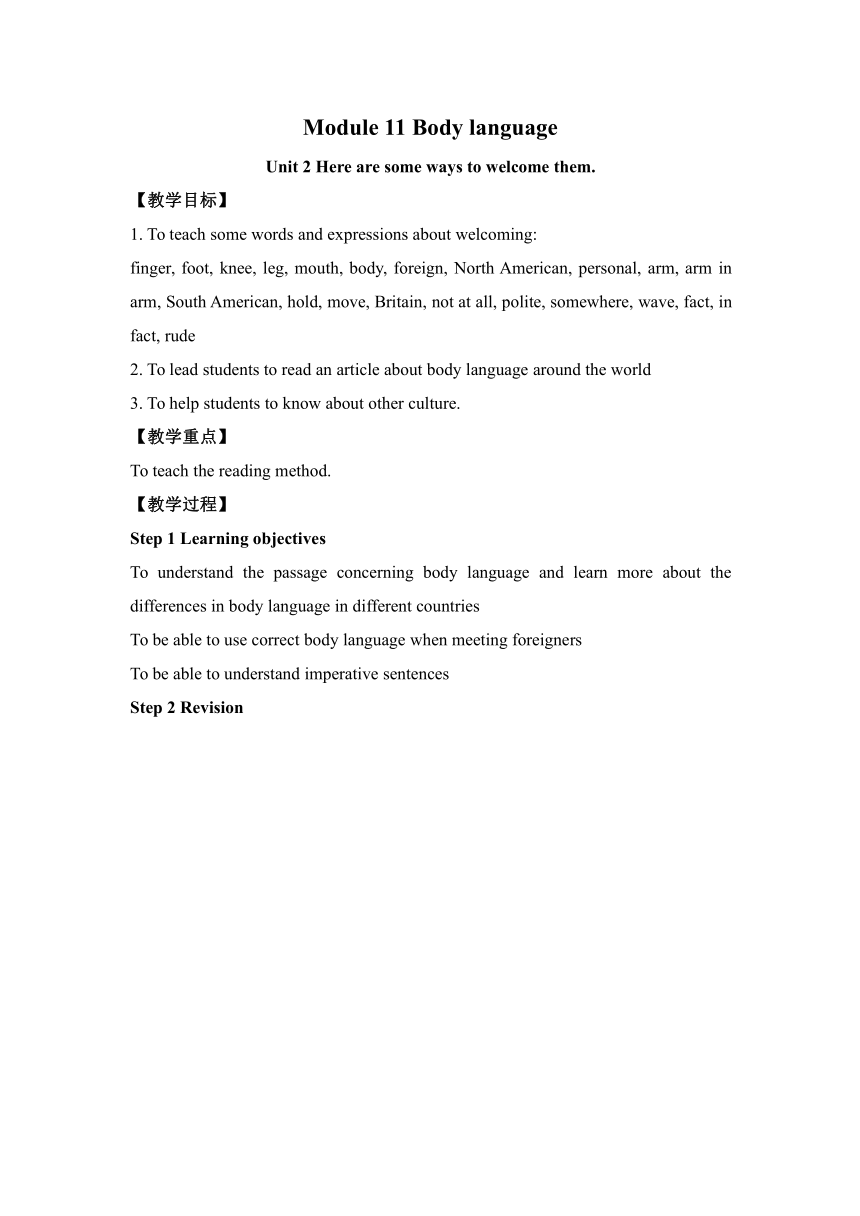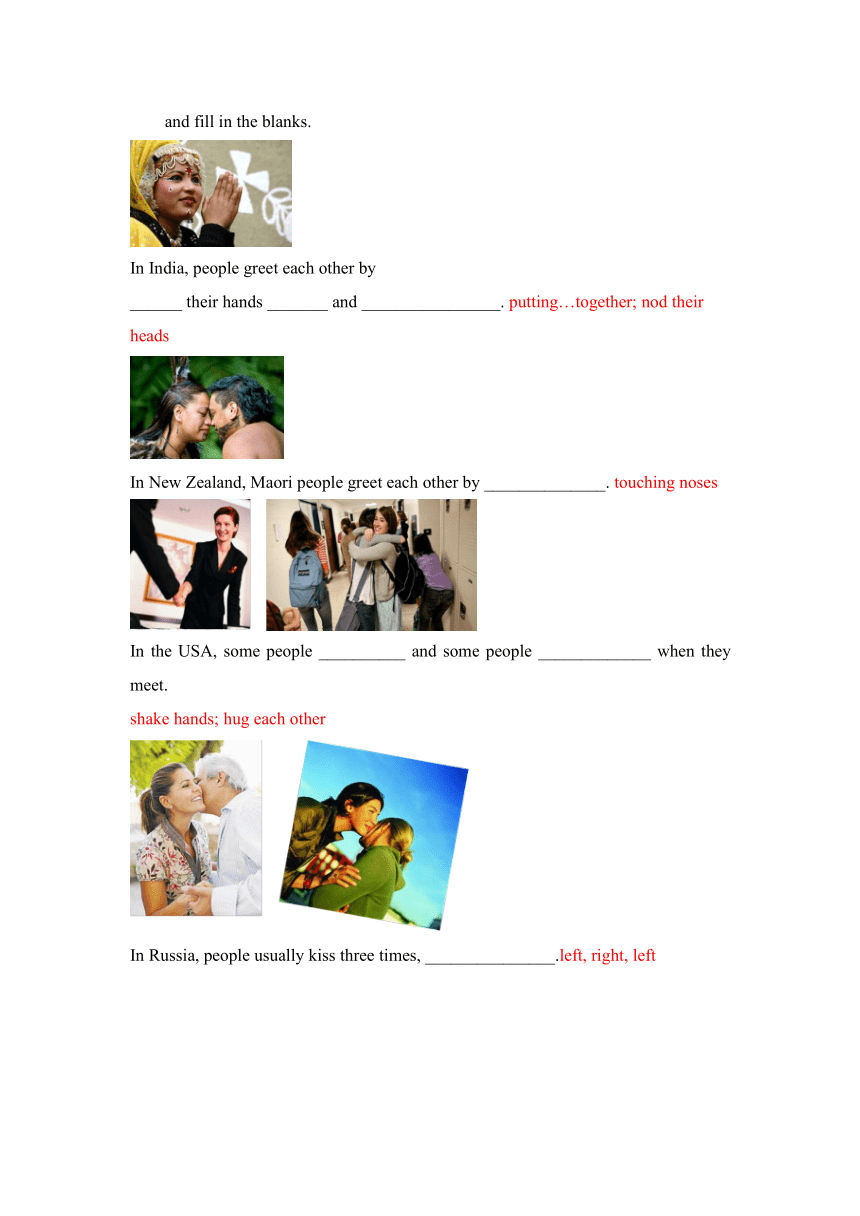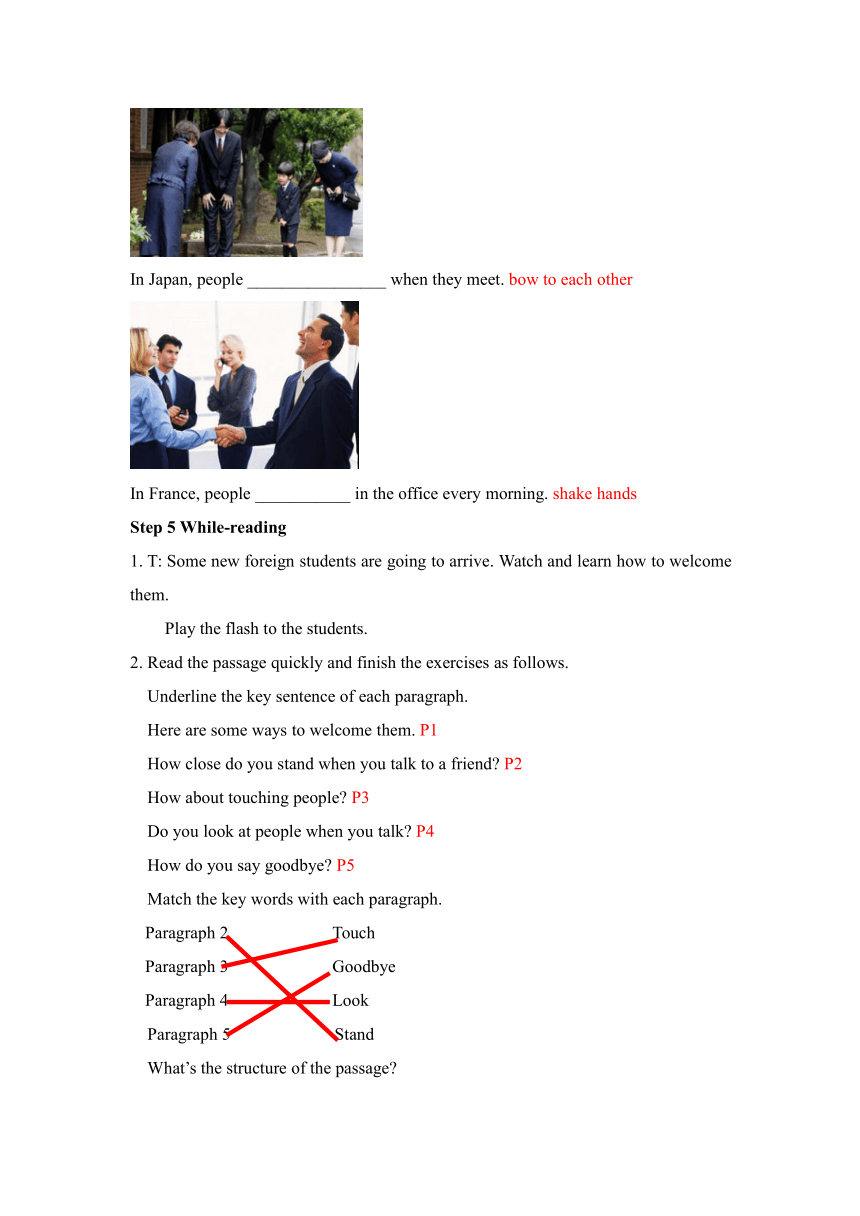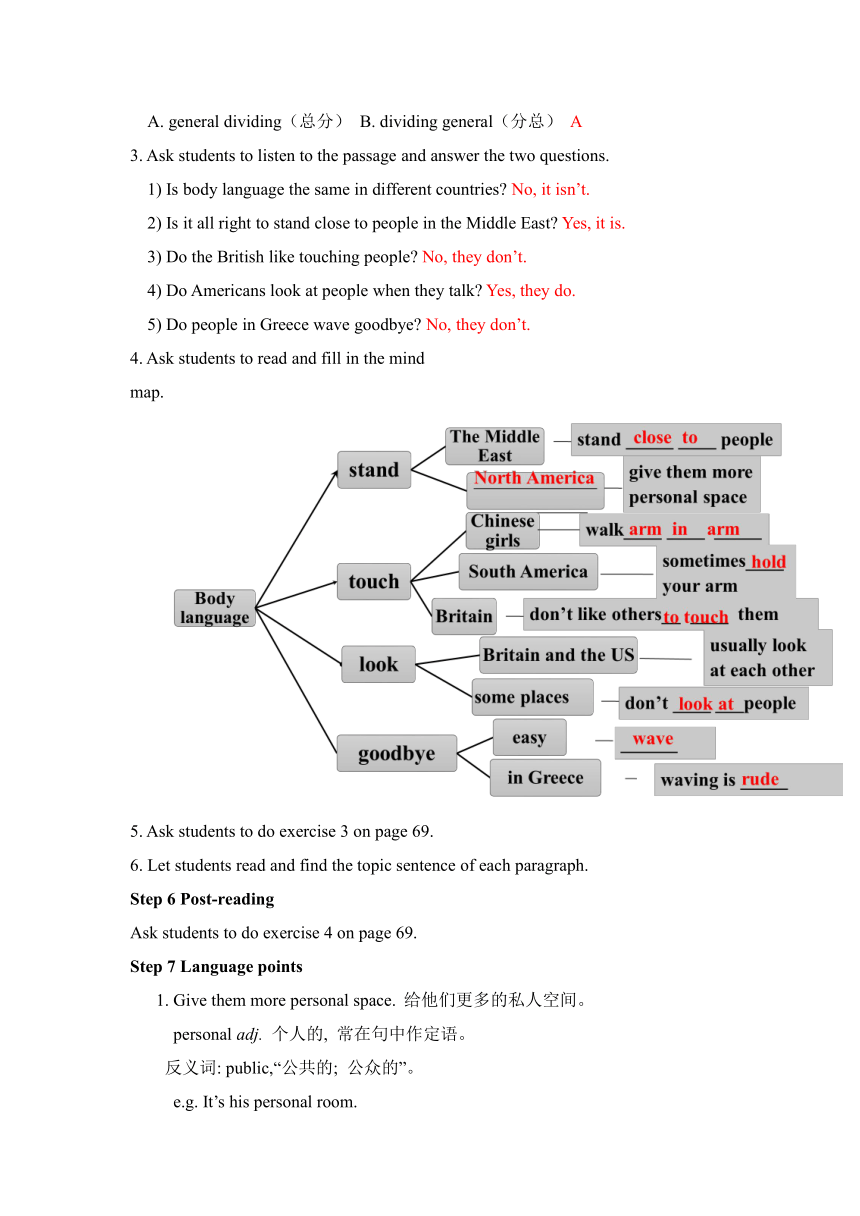Module 11 Unit 2 Here are some ways to welcome them教案 外研版英语七年级下册
文档属性
| 名称 | Module 11 Unit 2 Here are some ways to welcome them教案 外研版英语七年级下册 |  | |
| 格式 | docx | ||
| 文件大小 | 2.3MB | ||
| 资源类型 | 教案 | ||
| 版本资源 | 外研版 | ||
| 科目 | 英语 | ||
| 更新时间 | 2024-02-23 17:17:23 | ||
图片预览





文档简介
Module 11 Body language
Unit 2 Here are some ways to welcome them.
【教学目标】
1. To teach some words and expressions about welcoming:
finger, foot, knee, leg, mouth, body, foreign, North American, personal, arm, arm in arm, South American, hold, move, Britain, not at all, polite, somewhere, wave, fact, in fact, rude
2. To lead students to read an article about body language around the world
3. To help students to know about other culture.
【教学重点】
To teach the reading method.
【教学过程】
Step 1 Learning objectives
To understand the passage concerning body language and learn more about the differences in body language in different countries
To be able to use correct body language when meeting foreigners
To be able to understand imperative sentences
Step 2 Revision
Step 3 Consolidate new words
Look and say. Shows the pictures of new words and let the students to say as quickly as possible.
Step 4 Pre-reading
1. Match the words with the parts of the body
Look at the pictures and match the parts of the body.
2. Ask students to play a game.
T: Work in pairs and play a game! Who is faster
Touch your…
3. T: People around the world use different body language to greet each other. Read and fill in the blanks.
In India, people greet each other by
______ their hands _______ and ________________. putting…together; nod their heads
In New Zealand, Maori people greet each other by ______________. touching noses
In the USA, some people __________ and some people _____________ when they meet.
shake hands; hug each other
In Russia, people usually kiss three times, _______________.left, right, left
In Japan, people ________________ when they meet. bow to each other
In France, people ___________ in the office every morning. shake hands
Step 5 While-reading
1. T: Some new foreign students are going to arrive. Watch and learn how to welcome them.
Play the flash to the students.
2. Read the passage quickly and finish the exercises as follows.
Underline the key sentence of each paragraph.
Here are some ways to welcome them. P1
How close do you stand when you talk to a friend P2
How about touching people P3
Do you look at people when you talk P4
How do you say goodbye P5
Match the key words with each paragraph.
Paragraph 2 Touch
Paragraph 3 Goodbye
Paragraph 4 Look
Paragraph 5 Stand
What’s the structure of the passage
A. general dividing(总分) B. dividing general(分总) A
3. Ask students to listen to the passage and answer the two questions.
1) Is body language the same in different countries No, it isn’t.
2) Is it all right to stand close to people in the Middle East Yes, it is.
3) Do the British like touching people No, they don’t.
4) Do Americans look at people when they talk Yes, they do.
5) Do people in Greece wave goodbye No, they don’t.
4. Ask students to read and fill in the mind map.
5. Ask students to do exercise 3 on page 69.
6. Let students read and find the topic sentence of each paragraph.
Step 6 Post-reading
Ask students to do exercise 4 on page 69.
Step 7 Language points
1. Give them more personal space. 给他们更多的私人空间。
personal adj. 个人的, 常在句中作定语。
反义词: public,“公共的; 公众的”。
e.g. It’s his personal room.
【语境应用】将下面的汉语句子翻译成英语。
不要问任何私人的问题。那是不礼貌的。
_____________________________________________________
Don’t ask any personal questions. It’s not polite.
2. South Americans sometimes hold your arm when they talk to you, so you can’t move away.
南美人和你在交谈时有时会抓着你的胳膊,所以你不能走开。
hold (held/held) v. 握着; 使不动
hold on (to sth. / sb.) 抓紧;不放开(某物/某人)
e.g. The girl held her father’s hand.
女孩儿拉着她父亲的手。
【语境应用】完成句子。
1) 这个小女孩刚才紧紧地握着她父亲的手。
The little girl ______________________ tightly just now.
2) 我爷爷告诉我要抓紧椅子后背。
My grandpa told me ______________ the back of the chair.
move vi. 移动; 搬(家)
后跟宾语时需借助介词to, 其中to表示方向。
e.g. They moved to Shanghai in 1997.
他们97年搬到了上海。
move away 挪开, 走开
【语境应用】将下面的汉语句子翻译成英语。
明年他们将搬到上海。
_______________________________________________
3. But in Britain many people don’t like other people to touch them at all.
但在英国,许多人根本不喜欢别人碰他们。
not at all 一点也不,相当于not ... at all。
not at all 还可用于交际中,作回答道谢的客套语,意为“不用谢,哪儿的话”。
e.g. I don’t know her at all.
我根本不认识她。
—Thank you very much. 非常感谢。
—Not at all. 不用谢。
【语境应用】
Ⅰ. 完成句子。
我昨晚一点也不饿。
I _______ _______ _______ hungry last night.
Ⅱ. 单项选择。
—Thanks for helping me.
—_______.
A. Wait a moment B. Not at all
C. That'll be great D. Certainly not
4. In some places, it isn’t polite to look at people when you talk, but in other countries it isn’t polite to look somewhere else.
在某些地方,说话时看别人是不礼貌的,但在其他国家,看别的地方是不礼貌的。
polite adj. 礼貌的,其反义词为impolite和rude。
be polite to sb. 对某人有礼貌
It's polite to do sth. 做某事是有礼貌的
e.g. It’s polite to say thanks when other people help you.
【语境应用】翻译句子。
1) Rick对他的父母很有礼貌。
______________________________________________________
2) 问别人私人问题是不礼貌的。
______________________________________________________
3) 向老师问好是礼貌的。
______________________________________________________
5. In fact, it’s very rude! 事实上,这是非常粗鲁的!
in fact“事实上,实际上”, 相当于as a matter of fact。
e.g. In fact, I think you’re right.
事实上, 我认为你是对的。
In fact, we didn’t know the truth.
事实上,我们并不知道真相。
Step 8 Writing
1. Ask students to work in groups and talk about the class rules.
2. Let students make a list of class rules for new students in school.
Possible answers:
Don’t take another student’s things.
Don’t push anyone when in line.
Don’t shout.
Ask the teacher when you need to leave the class.
Walk quickly around the school.
Do what the teachers say the first time they ask.
Respect other students.
Be helpful to new students.
Step 9 Summary
North American 北美人
South American 南美人
arm in arm 臂挽臂地
not at all 一点也不
in fact 事实上
talk to sb. 与某人交谈
personal space 个人空间
hold one’s arm 抓住某人的胳膊
move away 走开
somewhere else 别的地方
Step 10 Exercises
Ⅰ. 观察图片,写出对应的表示身体部位的英语名称。
1. _________ 2. _________ 3. _________
4. _________ 5. _________ 6. _________
【想一想】
结合图片,想一想表示其他身体部位的单词并把它们写下来。比一比,看谁写得多。
________________________________________________________________________________________________________________________________________________________________
Ⅱ. 根据语境及所给汉语提示语或首字母提示写出或补全所缺单词。
1. The desk is heavy. Can you help me ________(移动) it
2. Jenny is friendly and ________(礼貌的). Everyone likes her.
3. We need to exercise to make our ________(身体) strong.
4. Lily was a little afraid so she h________ her father’s hand tight (紧紧地).
5. —How many f________ languages can you speak, Wang Hui
—Three — English, French and Japanese.
Ⅲ. 根据汉语意思完成英语句子,每空一词(含缩略形式)。
1. 事实上,我们每天都在使用身势语。
________ ________, we use body language every day.
2. 南美人擅长踢足球吗?
Are ________ ________ good at playing football
3. 那两个女孩臂挽臂地走进了学校。
The two girls entered the school ________ ________ ________.
4. 这本故事书一点也没意思。
This storybook ________ ________ ________ interesting.
5. Betty不准备回家,她要先去别的地方。
Betty isn’t going home. She has to go ________ ________ first.
look, wave, country, stand, rude, arm, touch, personal
Ⅳ. 根据短文内容,从方框中选择恰当的单词填空,使短文完整、通顺,注意形式变化。(短文由Unit 2的课文改写而来)
People from different (1)________ have different body language.
Many British people don’t like others to (2)________ them. But in South America, sometimes people hold your (3)________ when they talk to you. When you talk to people from the Middle East, you can (4)________ close to them. But you have to give more (5)________ space to North Americans. And in Britain and the US, people usually (6)________ at each other when they talk.
In most places, people (7)________ to say goodbye. But in Greece, it is (8)________ to do so. Please be careful!
Step 11 Homework
Write a short passage about the body language in China. You can use the following questions to help you.
How do Chinese greet each other when they meet
How do Chinese say goodbye
…
Unit 2 Here are some ways to welcome them.
【教学目标】
1. To teach some words and expressions about welcoming:
finger, foot, knee, leg, mouth, body, foreign, North American, personal, arm, arm in arm, South American, hold, move, Britain, not at all, polite, somewhere, wave, fact, in fact, rude
2. To lead students to read an article about body language around the world
3. To help students to know about other culture.
【教学重点】
To teach the reading method.
【教学过程】
Step 1 Learning objectives
To understand the passage concerning body language and learn more about the differences in body language in different countries
To be able to use correct body language when meeting foreigners
To be able to understand imperative sentences
Step 2 Revision
Step 3 Consolidate new words
Look and say. Shows the pictures of new words and let the students to say as quickly as possible.
Step 4 Pre-reading
1. Match the words with the parts of the body
Look at the pictures and match the parts of the body.
2. Ask students to play a game.
T: Work in pairs and play a game! Who is faster
Touch your…
3. T: People around the world use different body language to greet each other. Read and fill in the blanks.
In India, people greet each other by
______ their hands _______ and ________________. putting…together; nod their heads
In New Zealand, Maori people greet each other by ______________. touching noses
In the USA, some people __________ and some people _____________ when they meet.
shake hands; hug each other
In Russia, people usually kiss three times, _______________.left, right, left
In Japan, people ________________ when they meet. bow to each other
In France, people ___________ in the office every morning. shake hands
Step 5 While-reading
1. T: Some new foreign students are going to arrive. Watch and learn how to welcome them.
Play the flash to the students.
2. Read the passage quickly and finish the exercises as follows.
Underline the key sentence of each paragraph.
Here are some ways to welcome them. P1
How close do you stand when you talk to a friend P2
How about touching people P3
Do you look at people when you talk P4
How do you say goodbye P5
Match the key words with each paragraph.
Paragraph 2 Touch
Paragraph 3 Goodbye
Paragraph 4 Look
Paragraph 5 Stand
What’s the structure of the passage
A. general dividing(总分) B. dividing general(分总) A
3. Ask students to listen to the passage and answer the two questions.
1) Is body language the same in different countries No, it isn’t.
2) Is it all right to stand close to people in the Middle East Yes, it is.
3) Do the British like touching people No, they don’t.
4) Do Americans look at people when they talk Yes, they do.
5) Do people in Greece wave goodbye No, they don’t.
4. Ask students to read and fill in the mind map.
5. Ask students to do exercise 3 on page 69.
6. Let students read and find the topic sentence of each paragraph.
Step 6 Post-reading
Ask students to do exercise 4 on page 69.
Step 7 Language points
1. Give them more personal space. 给他们更多的私人空间。
personal adj. 个人的, 常在句中作定语。
反义词: public,“公共的; 公众的”。
e.g. It’s his personal room.
【语境应用】将下面的汉语句子翻译成英语。
不要问任何私人的问题。那是不礼貌的。
_____________________________________________________
Don’t ask any personal questions. It’s not polite.
2. South Americans sometimes hold your arm when they talk to you, so you can’t move away.
南美人和你在交谈时有时会抓着你的胳膊,所以你不能走开。
hold (held/held) v. 握着; 使不动
hold on (to sth. / sb.) 抓紧;不放开(某物/某人)
e.g. The girl held her father’s hand.
女孩儿拉着她父亲的手。
【语境应用】完成句子。
1) 这个小女孩刚才紧紧地握着她父亲的手。
The little girl ______________________ tightly just now.
2) 我爷爷告诉我要抓紧椅子后背。
My grandpa told me ______________ the back of the chair.
move vi. 移动; 搬(家)
后跟宾语时需借助介词to, 其中to表示方向。
e.g. They moved to Shanghai in 1997.
他们97年搬到了上海。
move away 挪开, 走开
【语境应用】将下面的汉语句子翻译成英语。
明年他们将搬到上海。
_______________________________________________
3. But in Britain many people don’t like other people to touch them at all.
但在英国,许多人根本不喜欢别人碰他们。
not at all 一点也不,相当于not ... at all。
not at all 还可用于交际中,作回答道谢的客套语,意为“不用谢,哪儿的话”。
e.g. I don’t know her at all.
我根本不认识她。
—Thank you very much. 非常感谢。
—Not at all. 不用谢。
【语境应用】
Ⅰ. 完成句子。
我昨晚一点也不饿。
I _______ _______ _______ hungry last night.
Ⅱ. 单项选择。
—Thanks for helping me.
—_______.
A. Wait a moment B. Not at all
C. That'll be great D. Certainly not
4. In some places, it isn’t polite to look at people when you talk, but in other countries it isn’t polite to look somewhere else.
在某些地方,说话时看别人是不礼貌的,但在其他国家,看别的地方是不礼貌的。
polite adj. 礼貌的,其反义词为impolite和rude。
be polite to sb. 对某人有礼貌
It's polite to do sth. 做某事是有礼貌的
e.g. It’s polite to say thanks when other people help you.
【语境应用】翻译句子。
1) Rick对他的父母很有礼貌。
______________________________________________________
2) 问别人私人问题是不礼貌的。
______________________________________________________
3) 向老师问好是礼貌的。
______________________________________________________
5. In fact, it’s very rude! 事实上,这是非常粗鲁的!
in fact“事实上,实际上”, 相当于as a matter of fact。
e.g. In fact, I think you’re right.
事实上, 我认为你是对的。
In fact, we didn’t know the truth.
事实上,我们并不知道真相。
Step 8 Writing
1. Ask students to work in groups and talk about the class rules.
2. Let students make a list of class rules for new students in school.
Possible answers:
Don’t take another student’s things.
Don’t push anyone when in line.
Don’t shout.
Ask the teacher when you need to leave the class.
Walk quickly around the school.
Do what the teachers say the first time they ask.
Respect other students.
Be helpful to new students.
Step 9 Summary
North American 北美人
South American 南美人
arm in arm 臂挽臂地
not at all 一点也不
in fact 事实上
talk to sb. 与某人交谈
personal space 个人空间
hold one’s arm 抓住某人的胳膊
move away 走开
somewhere else 别的地方
Step 10 Exercises
Ⅰ. 观察图片,写出对应的表示身体部位的英语名称。
1. _________ 2. _________ 3. _________
4. _________ 5. _________ 6. _________
【想一想】
结合图片,想一想表示其他身体部位的单词并把它们写下来。比一比,看谁写得多。
________________________________________________________________________________________________________________________________________________________________
Ⅱ. 根据语境及所给汉语提示语或首字母提示写出或补全所缺单词。
1. The desk is heavy. Can you help me ________(移动) it
2. Jenny is friendly and ________(礼貌的). Everyone likes her.
3. We need to exercise to make our ________(身体) strong.
4. Lily was a little afraid so she h________ her father’s hand tight (紧紧地).
5. —How many f________ languages can you speak, Wang Hui
—Three — English, French and Japanese.
Ⅲ. 根据汉语意思完成英语句子,每空一词(含缩略形式)。
1. 事实上,我们每天都在使用身势语。
________ ________, we use body language every day.
2. 南美人擅长踢足球吗?
Are ________ ________ good at playing football
3. 那两个女孩臂挽臂地走进了学校。
The two girls entered the school ________ ________ ________.
4. 这本故事书一点也没意思。
This storybook ________ ________ ________ interesting.
5. Betty不准备回家,她要先去别的地方。
Betty isn’t going home. She has to go ________ ________ first.
look, wave, country, stand, rude, arm, touch, personal
Ⅳ. 根据短文内容,从方框中选择恰当的单词填空,使短文完整、通顺,注意形式变化。(短文由Unit 2的课文改写而来)
People from different (1)________ have different body language.
Many British people don’t like others to (2)________ them. But in South America, sometimes people hold your (3)________ when they talk to you. When you talk to people from the Middle East, you can (4)________ close to them. But you have to give more (5)________ space to North Americans. And in Britain and the US, people usually (6)________ at each other when they talk.
In most places, people (7)________ to say goodbye. But in Greece, it is (8)________ to do so. Please be careful!
Step 11 Homework
Write a short passage about the body language in China. You can use the following questions to help you.
How do Chinese greet each other when they meet
How do Chinese say goodbye
…
同课章节目录
- Module 1 Lost and found
- Unit 1 Whose bag is this?
- Unit 2 Are they yours?
- Unit 3 Language in use
- Module 2 What can you do ?
- Unit 1 I can play the piano
- Unit 2 I can run really fast
- Unit 3 Language in use
- Module 3 Making plans
- Unit 1 What are you going to do at the weekends?
- Unit 2 We're going to cheer the players.
- Unit 3 Language in use
- Module 4 Life in the future
- Unit 1 Everyone will study at home
- Unit 2 Every family will have a small plane.
- Unit 3 Language in use
- Module 5 Shopping
- Unit 1 What can I do for you?
- Unit 2 You can buy everything on the Internet
- Unit 3 Language in use
- Module 6 Around town
- Unit 1 Could you tell me how to get to the Nationa
- Unit 2 The London Eye is on your right.
- Unit 3 Language in use
- Revision module A
- Module 7 My past life
- Unit 1 I was born in a small village.
- Unit 2 I was born in Quincy.
- Unit 3 Language in use
- Module 8 Story time
- Unit 1 Once upon a time….
- Unit 2 Goldilocks hurried out of the house.
- Unit 3 Language in use
- Module 9 Life history
- Unit 1 He left school and began work at the age of
- Unit 2 He decided to be an actor.
- Unit 3 Language in use
- Module 10 A holiday journey
- Unit 1 What did you do?
- Unit 2 This morning we took a walk.
- Unit 3 Language in use
- Module 11 Body language
- Unit 1 They touch noses!
- Unit 2 Here are some ways to welcome them.
- Unit 3 Language in use
- Module 12 Western music
- Unit 1 It's so beautiful!
- Unit 2 Vienna is the centre of European classical
- Unit 3 Language in use
- Revision module B
